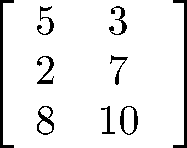Chapter 7. Matrices
...when the chips are down we close the office door and compute with matrices like fury.
The matrix is, at heart, nothing more than a way of organizing numbers into a rectangular grid. Matrices are like logarithms, or Fourier transforms: they’re not so much data structures as different representations for data. These representations take some time to learn, but the effort pays off by simplifying many problems that would otherwise be intractable.
Many problems involving the behavior of complex systems are represented with matrices. Wall Street technicians use matrices to find trends in the stock market; engineers use them in the antilock braking systems that apply varying degrees of pressure to your car tires. Physicists use matrices to describe how a soda can thrown into the air, with all its ridges and irregularities, will strike the ground. The echo canceller that prevents you from hearing your own voice when you speak into a telephone uses matrices, and matrices are used to show how the synchronized marching of soldiers walking across a bridge can cause it to collapse (this actually happened in 1831).
Consider a simple
![]() matrix:
matrix:

This matrix has three rows and two columns: six elements altogether. ...
Get Mastering Algorithms with Perl now with the O’Reilly learning platform.
O’Reilly members experience books, live events, courses curated by job role, and more from O’Reilly and nearly 200 top publishers.

